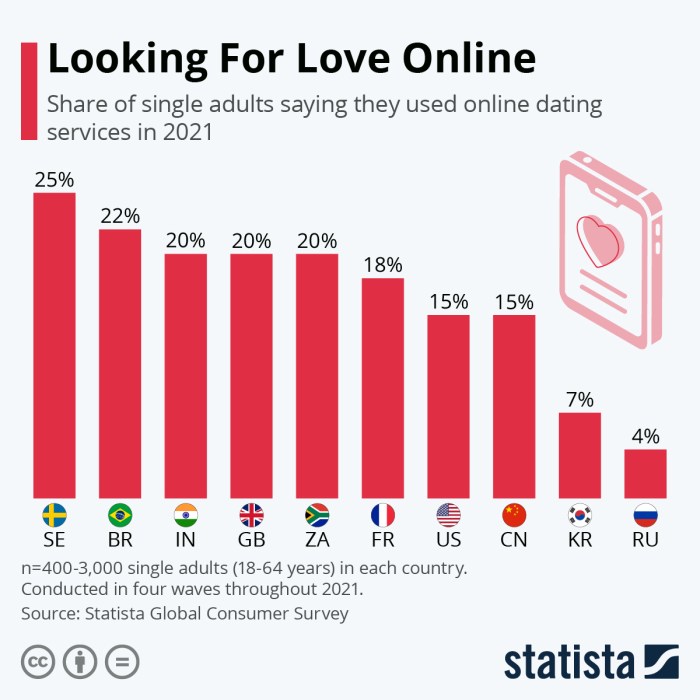Navigating the US dating scene can feel like deciphering a complex code. Success isn't just about luck; it's a blend of understanding relationship dynamics, cultural nuances, and practical strategies. This guide delves into the key elements that contribute to finding and maintaining fulfilling relationships in the diverse landscape of American dating.
From mastering effective communication and resolving conflicts constructively to understanding the impact of cultural backgrounds and navigating the digital dating world, we'll explore the multifaceted aspects of building lasting connections. We'll examine how regional differences, social media influence, and personal self-awareness play crucial roles in shaping dating experiences and ultimately, achieving romantic success.
Relationship Dynamics in US Dating
Navigating the complexities of US dating requires understanding the nuanced dynamics that contribute to successful relationships. Successful partnerships aren't built on chance; rather, they are cultivated through conscious effort, effective communication, and shared life goals. This section explores key elements of relationship dynamics prevalent in thriving US couples.Communication Styles in Successful US Dating Relationships
Effective communication forms the bedrock of any strong relationship. In successful US dating relationships, partners often employ open and honest communication styles. This involves active listening, expressing needs and feelings clearly and respectfully, and practicing empathy. They avoid accusatory language and instead focus on using "I" statements to express their perspectives. Regular check-ins and open dialogue about expectations, concerns, and personal growth are common practices. A willingness to compromise and find mutually agreeable solutions is also crucial. Furthermore, nonverbal communication, such as body language and tone of voice, are carefully considered to ensure alignment with verbal communication.Healthy Conflict Resolution Strategies in Thriving US Couples
Disagreements are inevitable in any relationship. However, how couples handle these conflicts significantly impacts their long-term success. Thriving US couples typically employ healthy conflict resolution strategies that emphasize mutual respect and understanding. They avoid personal attacks and focus on addressing the specific issue at hand. Compromise and negotiation are common approaches, with both partners striving to find solutions that meet each other's needs, at least partially. Active listening during disagreements is crucial, allowing each partner to feel heard and understood. Taking breaks when emotions run high and returning to the conversation later with a calmer demeanor is also a common and effective strategy. Seeking professional help from a therapist or counselor isn't viewed as a sign of weakness, but rather a proactive step towards strengthening the relationship when necessary.Shared Values and Life Goals in Long-Term Relationship Success
Shared values and life goals serve as a strong foundation for long-term relationship success in the US. Couples who share similar beliefs about family, finances, career aspirations, and personal growth tend to experience greater harmony and stability. This doesn't necessitate complete alignment on every aspect of life, but rather a fundamental agreement on core values that guide their decisions and shape their future together. Open and honest conversations about long-term goals, such as marriage, children, or career paths, are essential for ensuring compatibility and avoiding potential conflicts down the line. A willingness to support each other's individual goals while maintaining a shared vision for the future is key.The Role of Emotional Intelligence in US Dating
Emotional intelligence plays a crucial role in navigating the complexities of US dating. This involves self-awareness (understanding one's own emotions and how they impact others), self-regulation (managing emotions effectively), empathy (understanding and sharing the feelings of others), and social skills (building and maintaining healthy relationships). Partners with high emotional intelligence are better equipped to handle conflict constructively, communicate effectively, and build strong emotional connections. They are able to identify and address their own emotional needs, as well as empathize with and support their partner's emotional well-being. This fosters trust, intimacy, and a deeper sense of connection.Communication Styles in Successful vs. Unsuccessful US Dating Relationships
| Communication Style | Successful Relationship Example | Unsuccessful Relationship Example | Analysis |
|---|---|---|---|
| Active Listening | Partner A paraphrases Partner B's concerns to ensure understanding before responding. | Partner A interrupts Partner B frequently, dismissing their feelings. | Active listening fosters empathy and validation, crucial for conflict resolution. Interruptions create defensiveness and hinder understanding. |
| Expression of Needs | Partner A uses "I" statements to express their needs without blaming Partner B. | Partner A uses accusatory language, blaming Partner B for their unhappiness. | "I" statements promote open communication and avoid defensiveness. Accusations create conflict and prevent productive dialogue. |
| Conflict Resolution | Partners A and B collaboratively brainstorm solutions, focusing on mutual compromise. | Partners A and B engage in shouting matches, avoiding compromise and resorting to personal attacks. | Collaborative problem-solving builds trust and strengthens the relationship. Avoidance and aggression damage the relationship and escalate conflict. |
| Nonverbal Communication | Partners A and B maintain eye contact, use affirming body language, and speak in a calm tone. | Partner A rolls their eyes, avoids eye contact, and uses a sarcastic tone while speaking to Partner B. | Positive nonverbal cues reinforce verbal communication and build connection. Negative nonverbal cues undermine trust and create distance. |
Cultural Influences on US Dating Success

Source: hackspirit.com
Regional Differences in Dating Preferences and Expectations
The United States, despite its national identity, exhibits significant regional variations in dating norms and expectations. For example, the fast-paced, direct approach common in some urban areas, particularly on the coasts, contrasts sharply with the more traditional and relationship-oriented approaches prevalent in certain parts of the South or Midwest. In the Northeast, dating might be characterized by a more independent and less overtly romantic style, while in the South, a more traditional courting approach, emphasizing family and community involvement, might be observed. These differences influence everything from initial interactions to the pace of relationship progression. Even within a single state, significant differences can exist between urban and rural areas.Influence of Cultural Background on Relationship Dynamics
Cultural background, encompassing ethnicity and religion, profoundly shapes dating dynamics in the US. Individuals from different ethnic groups may hold varying views on family involvement in dating, gender roles, and expressions of affection. For instance, some cultures may emphasize arranged marriages or family approval, while others prioritize individual autonomy in choosing partners. Religious beliefs also play a significant role, influencing attitudes towards premarital sex, cohabitation, and the overall trajectory of relationships. Understanding these diverse perspectives is crucial for fostering successful inter-cultural relationshipsCommon Cultural Misconceptions Hindering Dating Success
Several common cultural misconceptions can impede dating success in the US. One such misconception is the assumption of homogeneity within ethnic or religious groups. Diversity within any group is significant, and generalizations can lead to inaccurate assessments of individual preferences and values. Another misconception involves assuming that all Americans share the same dating expectations, ignoring the significant regional and cultural differences discussed earlier. Overlooking these differences can result in misinterpretations of behaviors and intentions, hindering effective communication and connection. A third misconception is the belief that online dating eliminates the need for cultural awareness. Online profiles often reveal cultural clues, and understanding these nuances remains critical for successful online interactions and subsequent real-life encounters.Comparison of Dating Approaches in Different US Subcultures
Dating approaches vary significantly across different US subcultures. For instance, the dating culture within the LGBTQ+ community often differs from heterosexual dating, with unique platforms, social events, and relationship expectations. Similarly, within specific religious communities, dating practices may be guided by religious teachings and traditions, influencing everything from the initial stages of courtship to the eventual commitment. The dating experiences of immigrant communities often reflect a blend of their cultural heritage and the prevailing US dating norms, creating a unique dynamic that deserves careful consideration. Comparing and contrasting these approaches helps to appreciate the multifaceted nature of dating in the US.Impact of Social Media on US Dating Culture and Relationship Success
Social media has revolutionized US dating culture, significantly impacting relationship success, both positively and negatively.- Increased Accessibility: Dating apps and social media platforms have broadened the pool of potential partners, transcending geographical limitations.
- Enhanced Communication: Social media facilitates communication and relationship building before and during in-person interactions.
- Potential for Misrepresentation: Online profiles may not accurately reflect reality, leading to disappointment upon meeting in person.
- Comparison and Competition: Constant exposure to others' relationships on social media can fuel insecurity and unrealistic expectations.
- Privacy Concerns: Sharing personal information online carries inherent risks, potentially impacting relationship safety and trust.
- Cyberbullying and Harassment: Online platforms can unfortunately be breeding grounds for negative interactions.
- Shifting Relationship Dynamics: Social media influences how relationships are initiated, maintained, and sometimes even terminated.
Practical Strategies for US Dating Success

Source: statcdn.com